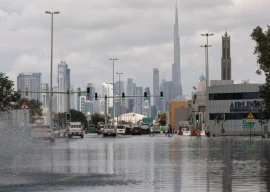
A team of consultants constituted by the Indus River System Authority (Irsa) has found that Balochistan is currently receiving less than the total amount of water entitled to it.
The team is responsible for measuring the water discharge at designated spots in order to determine the distribution of water between Punjab, Sindh and Balochistan.
On Sunday, the team visited the Garang regulator, located between Shahdadkot and Dera Murad Jamali on the Sindh-Balochistan border and found that Balochistan is receiving 300 cusecs of water less than the amount it is entitled to.
The team measured the discharge at Garang regulator to ascertain the quantity of water supplied to Balochistan and found that instead of 2,400 cusecs, Balochistan receives 2,105 cusecs of water. However, Sindh’s Superintendent Engineer Bhai Khan Lakho said that, according to the 1991 Water Accord, Balochistan is entitled to receive 2,200 cusecs and a shortfall of 95 cusecs has been recorded. Superintendent Engineer Irrigation Right Bank Balochistan Abdul Sattar Lakhiti was also present during the visit.
Sources said that Balochistan is entitled to 2,200 cusecs under the 1991 accord and, according to a letter written by Irsa, the province will receive 2,400 cusecs, which is unacceptable to the Sindh irrigation authorities. Despite a shortage in Sindh, Balochistan is receiving 2,300 cusecs of water and due to water theft in either province, Balochistan receives 200 cusecs less.
“The water is passing through the North West Canal, passing from Shikarpur and Jacobabad districts, where the law and order situation is deteriorating,” Lakho told The Express Tribune. “In 2002, the Sindh government took measures to curb water theft in these areas and as a result, more than 15 irrigation employees were killed,” he added. Superintendent Engineer Right Bank Balochistan Abdul Sattar Lakhiti was not available for comment.
Irsa’s consultant committee is responsible for measuring water discharge at Chashma Barrage, Taunsa Barrage, Guddu Barrage and Garang regulator.
In-charge control room Sukkur Barrage Abdul Aziz Soomro told The Express Tribune that according to Monday’s measurements, 217,000 cusecs was recorded upstream at Chashma Barrage and 215,000 cusecs downstream. Upstream at Taunsa Barrage was 240,000 cusecs and downstream was recorded at 216,000 cusecs. Upstream at Guddu Barrage was 204,000 cusecs and downstream was 165,000 cusecs. Upstream at Sukkur Barrage was 138,000 cusecs and downstream was 82,000 cusecs and at Kotri Barrage upstream was 66,500 cusecs, while 26,100 cusecs water was being released in its downstream. Overall, a shortage of five per cent is being experienced at all three barrages of Sindh, he added.
Published in The Express Tribune, July 22nd, 2014.
COMMENTS (1)
Comments are moderated and generally will be posted if they are on-topic and not abusive.
For more information, please see our Comments FAQ












































All areas should receive amount of water based on their needs.